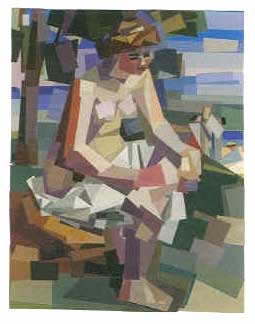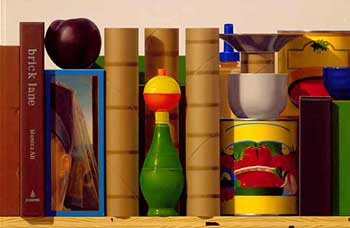
Season Openers
Ken Kewley’s collages at Lori Bookstein; Michael Tompkins’s still lifes come to New York; Biomorphic abstraction from the 1940s at Michael Rosenfeld.
By Maureen Mullarkey
 |
Ken Kewley's Bather (after Renoir) 2005 |
KEN KEWLEY’S FIRST SOLO SHOW at Lori Bookstein is a sophisticate’s delight. A smart, lively colorist, his instinct for planes and values makes collage a natural route to fractured but fully legible representation. Miniature formats belie the complexity of these collages. He considers modelled forms from a rhythmic point of view, creating an opposition of tonal movements that yields multiple color harmonies. His figures are particularly captivating, calling to mind the planar intelligence of Andre L’Hote’s leavened Cubism. Do not miss the pleasure of it.




IF YOU LIKE ENIGMAS, YOU WILL ENJOY Michael Tompkins’s dense still life constructions, debuting in New York at Paul Thiebaud Gallery. Mr. Tompkins raids the pantry, selecting objects for their formal qualities: size, shape or color. He arranges disparate items at eye level in interlocking architectural units that yield an ingenious sculptural harmony—not unlike one of Louise Nevelson’s boxed constructions. Dissimilar textures and materials plus an occasional apple or pear are unified by a complex geometry that implies a solidity that is not there at all. Such is the paramount illusion at work in these wonderfully artificial realities.
 |
| Michael Tompkins's Mackerel's Barge (detail) 2005 |
Spatial ambiguities learned from Morandi combine with multiple perspective points (more accurately, single point perspective repeated at every eye stop) to destabilize the seeming realism of the composition. Surely his shelf is too shallow for that bulging detergent bottle tucked behind a tomato can. What slender book can stand unsupported, a dish poised on its spine, like the one in “Container” (2004)? But Tompkins’s mise-en-scène obeys compositional needs first; gravity and true measure can wait.
Worked in oil on gessoed panels, his surface recalls William Harnett’s methodical literalness. This encourages categorization as trompe l’oeil; and so it is, up to a point. But the work’s internal coherence is conceptual and suggestive, not imitative. Berkeley-based, Mr. Tompkins’s debt to Wayne Thiebaud is clear; less so are subtle links to John F. Peto. Like Peto, he uses books both as geometric units independent of their descriptive value and as totems of culture. While brand names and texts on packaged goods are illegible, book titles are lovingly delineated, signals of intellectual life. “Arrangement with Lemon and Lime” (2005), a congested assemblage dominated by books, follows Peto’s emphasis on the fragile stability of their confinement.




HAVE YOU EVER FELT STIFLED BY AN EXHIBITION? Ever wondered if art—and the sham profundity it generates—might not be good for you?
Michael Rosenfeld Gallery’s exhibition of 25 abstract Surrealist works is a sampler of the genesis of Abstract Expressionism. Sixty years out, these biomorphic testaments to automatism and the unleashed subconscious look as dated as the mirrored cocktail tables, gathered peplums and cork wedgies of the 1940s. One of the more airless idioms ever produced, its supporting assumptions and rhetoric have become the table salt of contemporary culture, so pervasive and taken-for-granted, that we do not notice how the additive has increased with the decades.
This exhibition spans the most momentous years of the 20th century, from 1941 to 1949. It begins in the year of Pearl Harbor, extends through the agonies of World War II, and continues into the onset of the Cold War. Yet looking into this petri dish for the New York School, you would think the only reality was the imagining Self. Sweaty with disdain for the “decaying” middle class (Motherwell’s word, notwithstanding Rosie the Riveter), artists of the period presumed to uncover latent organic forms in the recesses of their own subconscious. While Vogue campaigned on “Mend and Make Do” and McCalls produced patterns for cutting down men’s suits into ladies’ wear, artists practiced free association to “release” images from blank canvas.The war years and their immediate aftermath saw shortages of everything except art’s militant solipsism. Or as Charles Seliger (b. 1926) pronounced grandly: “I have interpreted the concepts of chaos and complexity as a personal aesthetic.”
Mr. Seliger’s scraped and reworked surfaces can be appealing but neither of the paintings on view, both from 1945, achieve a convincing vocabulary. Gestural abstraction pivots on one natural hand motion: the looping arabesque. Most of the work here is structured on this limited syntax. Painting that, in John Yau’s phrase, “defines its own necessity” becomes incidental, given time and changed circumstances.
Norman Lewis (1909-1979) preserved the inherent gracefulness of seried arabesques in “Harlem Gate” (1949) and Theodore Stamos (1922-1997) turned his into a bird on a branch. But Pavel Tchelitchew’s “Interior Landscape” (1945) is just silly. Delicately tinted spaghetti-like strands cascade over creepy suggestions of a head. Like many things here, it leaves an impression of good paint desperate for some place to put itself.
Jimmy Ernst (1920-1984), son of Dada-Surrealist Max, had his diapers changed by Paul Klee and got piggy-back rides from Jean Arp. Small wonder that it took time for him to develop his own iconography. The 1947 painting here, with its fine lines and frosted planes, is prologue to the quietly pulsing, coloristic imagery that grew more interesting as he left Surrealist cliché behind. Gerome Kamrowski’s “Burning Spider Web” (1946), with its fanciful, all-over, meandering shapes, calligraphic tracery, and vermilion flame-burst against clear blue and adjacent hues, holds up well. His paint is undeniably beautiful: lapidary colors finessed with controlled elegance and gently nuanced with feather-light scumbles.
One still-fresh and compelling work is an untitled qouache by Richard Pousette-Dart from 1944. An intricate mandala-like pattern interwoven with subsidiary forms and color harmonies, this characteristic, ordered piece transcends the improvisations of his contemporaries. Difficult to classify, Pousette-Dart reminds us that staying power resides outside the conceits of one’s era.




“Ken Kewley: Collages” at Lori Bookstein Fine Art (37 West 57th Street, 212-750-0949).
“Michael Tompkins: Recent Paintings” at Paul Thiebaud Gallery (42 East 76th Street, 212-737-9759).
“Organic New York: 1941 - 1949” at Michael Rosenfeld Gallery (24 West 57th Street, 212-247-0082).
A version of this review appeared in The New York Sun, September 15, 2005.
Copyright 2005 Maureen Mullarkey







